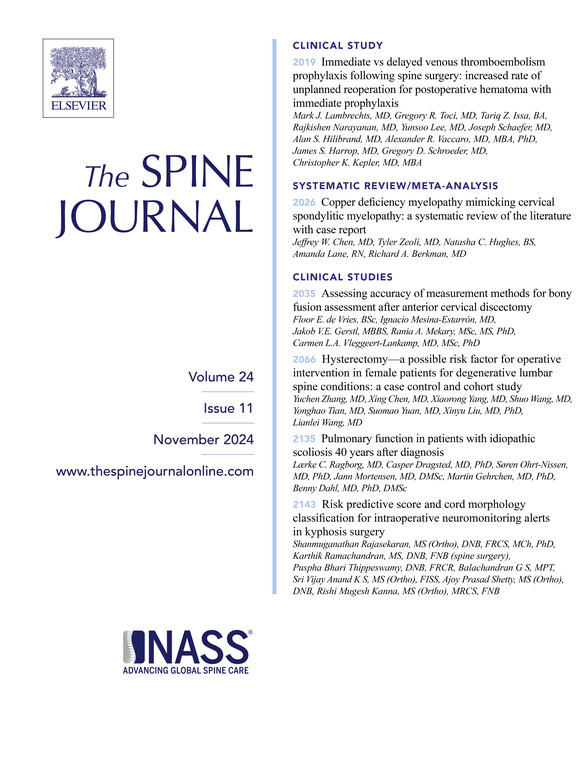The predictive value of intraoperative bulbocavernosus reflex monitoring for postoperative voiding function in patients with conus medullaris and cauda equina tumors: a retrospective single center study
IF 4.9
1区 医学
Q1 CLINICAL NEUROLOGY
引用次数: 0
Abstract
BACKGROUND CONTEXT
Surgical resection is the preferred treatment in most conus medullaris and cauda equina tumor (CMCET) cases. However, total resection is usually challenging to obtain and has a strong possibility of causing various complications if forcibly attempted. Intraoperative neurophysiological monitoring (IONM) has become a necessary adjunctive tool for CMCET resection.
PURPOSE
The current study aimed to evaluate the application value of bulbocavernosus reflex (BCR) monitoring in CMCET surgery.
STUDY DESIGN
A retrospective clinical study.
PATIENT SAMPLE
The medical records of patients who underwent CMCET resection by the same neurosurgical team at our hospital from September 2020 to June 2022 were retrospectively reviewed. IONM was conducted in all surgeries. According to inclusion criteria and exclusion criteria, ultimately, 105 patients were enrolled in the study.
OUTCOME MEASURES
The voiding function was assessed before surgery, 1 month after, and 6 months after surgery using the Neurogenic Bladder Symptom Score (NBSS). If the NBSS obtained 1 month after surgery exceeds 9 points than that before surgery, it can be considered that the patient suffered new-onset postoperative voiding dysfunctions (PVDs). Moreover, if the NBSS could restored (less than 9 points higher than before the surgery) at 6 months after surgery, it was defined as a short-term PVD. Otherwise, it was defined as a long-term PVD.
METHODS
The amplitude reduction ratios (ARRs) of bilateral BCR waveforms were calculated and compared between patients with PVDs and those without. The receiver operating characteristic curve analysis was subsequently applied to determine the cut-off value of the maximal and minimal ARRs for predicting PVDs.
RESULTS
The maximal and minimal ARRs were significantly correlated with short-term and long-term PVDs (p<.001 for all comparisons, Mann-Whitney U test). The threshold values of maximal ARR for predicting short-term and long-term PVD were 68.80% (AUC=0.996, p<.001) and 72.10% (AUC=0.996, p<.001), respectively. While those of minimal ARR were 50.20% (AUC=0.976, p<.001) and 53.70% AUC=0.999, p<.001).
CONCLUSIONS
The amplitude reduction of intraoperative bilateral BCR waveforms showed high predictive value for PVDs.
术中球海绵体回缩监测对锥髓和马尾肿瘤患者术后排尿功能的预测价值:一项回顾性单中心研究。
背景情况:手术切除是大多数延髓和马尾肿瘤(CMCET)病例的首选治疗方法。然而,完全切除通常具有挑战性,如果强行尝试,极有可能引起各种并发症。目的:本研究旨在评估球海绵体反射(BCR)监测在 CMCET 手术中的应用价值:研究设计:回顾性临床研究:回顾性审查了2020年9月至2022年6月在我院由同一神经外科团队进行CMCET切除术的患者的病历。所有手术均进行了 IONM。根据纳入标准和排除标准,最终有105名患者被纳入研究:使用神经源性膀胱症状评分(NBSS)对术前、术后一个月和术后六个月的排尿功能进行评估。如果术后一个月的NBSS比术前超过9分,则可认为患者术后出现了新的排尿功能障碍(PVDs)。此外,如果术后 6 个月 NBSS 能够恢复(比术前高出 9 分以下),则被定义为短期 PVD。方法:方法:计算双侧 BCR 波形的振幅缩小比(ARRs),并在有 PVD 的患者和无 PVD 的患者之间进行比较。随后应用接收器操作特征曲线分析法确定预测 PVD 的最大和最小 ARR 的临界值:结果:最大和最小 ARR 与短期和长期 PVDs 有显著相关性(p 结论:术中双侧振幅减小与 PVDs 有显著相关性:术中双侧 BCR 波形的振幅减小对 PVDs 有很高的预测价值。
本文章由计算机程序翻译,如有差异,请以英文原文为准。
求助全文
约1分钟内获得全文
求助全文
来源期刊

Spine Journal
医学-临床神经学
CiteScore
8.20
自引率
6.70%
发文量
680
审稿时长
13.1 weeks
期刊介绍:
The Spine Journal, the official journal of the North American Spine Society, is an international and multidisciplinary journal that publishes original, peer-reviewed articles on research and treatment related to the spine and spine care, including basic science and clinical investigations. It is a condition of publication that manuscripts submitted to The Spine Journal have not been published, and will not be simultaneously submitted or published elsewhere. The Spine Journal also publishes major reviews of specific topics by acknowledged authorities, technical notes, teaching editorials, and other special features, Letters to the Editor-in-Chief are encouraged.
 求助内容:
求助内容: 应助结果提醒方式:
应助结果提醒方式:


